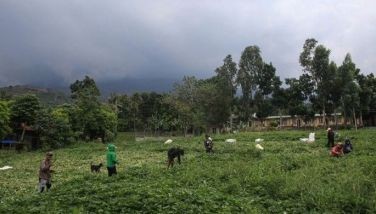Explainer: Why Mindanao is experiencing consecutive powerful quakes
MANILA, Philippines— At least three powerful earthquakes hit Mindanao region in the span of two weeks, with the latest recorded Thursday.
The Philippine Institute of Volcanology and Seismology also recorded hundreds of aftershocks from these quakes but Erlinton Olavere, Phivolcs Science Research Specialist, said the earthquakes with magnitude 6.6 last Tuesday and 6.5 on Thursday were not mere aftershocks but interrelated tremors.
“Siguro hindi natin masasabi na aftershock ito (magnitude 6.5 quake) almost same e,” Olavere said over an interview with CNN Philippines.
(We can’t say this (magnitude 6.5 quake) is an aftershock, it’s almost the same)
A magnitude 6.3 earthquake was recored in Tulunan, North Cotabato on October 16.
Why are earthquakes occurring in North Cotabato?
Olavere said that after a strong earthquake, the magnitude of subsequent tremors are usually on a downtrend after a day or two. However, this was not the case for North Cotabato.
Phivolcs attributed the consecutive powerful quakes in Mindanao to the interrelated faults.
“Kasi magkakatabi ‘yung fault na identified,” Olavere said.
In an October 29 earthquake primer, Phivolcs also explained why the quakes are occurring in Cotabato.
Cotabato is the official name of the province that is also commnonly referred to as North Cotabato.
“Central Mindanao (SOCCSKSARGEN Region), which includes Cotabato, is one of the seismically active regions in the country because of the presence of several active faults in the area which include the M’lang Fault, Makilala-Malungon Fault, North Columbio Fault, South Columbio Fault, and the western extension of the Mindanao Fault (Cotabato-Sindangan Fault),” Phivolcs said.
“Cotabato Trench is also a major source of earthquakes, which can affect the region. In addition, there are other nearby local faults, some of which may be covered by recent deposits, and could be sources of small to strong magnitude earthquakes,” it added.
Olavere said the faults mentioned probably generate the powerful quakes.
“So possibly nagkakaroon ng adjustment or gumalaw ‘yung fault dahil nagre-react ‘yung isang fault din,” the Phivolcs research specialist said.
(So it’s possible that there’s an adjustment or the faults are moving because the other fault is reacting)
“Kaya mapapansin natin malalakas na magnitude 6.6, then we have a 6.1, then we have a 6.5 today and two weeks before nagkaroon din tayo ng 6.3,” he said.
(That’s why you can notice that the quakes are powerful like the magnitude 6.6, then we have a 6.1, then we have a 6.5 today and two weeks before there was a 6.3)
Volcanic activity and tsunami threats
While the recent earthquakes recorded in the Mindanao region are strong, Phivolcs clarified that these does not indicate volcanic activity.
“Although the nearest active volcanoes from the epicenter are Matutum Volcano (46 kilometers) and Parker Volcano (76 km), the M6.6 event and succeeding earthquakes are tectonic in origin,” Phivolcs said.
“However, as part of DOST-PHIVOLCS monitoring procedures for moderate to large earthquakes occurring near active volcanoes, the Institute will closely monitor earthquake events in relation to any activity that may be associated with Matutum and Parker Volcanoes,” it added.
The institute also said the recent tremors may not trigger tsunami because the epicenter of the earthquake is inland.
“Cotabato is also landlocked, hence it is safe from tsunami. Based on the current Active Faults and Trenches Map of PHIVOLCS, the tsunami threat for Sultan Kudarat, Sarangani and adjacent coastal areas in the SOCCSKSARGEN Region would come from the movement of the Cotabato Trench, located west of this region,” Phivolcs said.
“Also, the tsunami threat for Davao Region would come from the movement of the Philippine Trench or other offshore active faults, located east of this region. Other sources of tsunamis which may affect the coastal communities of southern Mindanao would come from movement of the Sangihe, Halmahera and North Sulawesi Trenches located farther south offshore of Mindanao,” it added.
Can stronger earthquakes occur?
Phivolcs said that it is expecting small-to-moderate magnitude earthquakes to continue for several days to weeks.
“Although the occurrence of another earthquake higher than M6.6 cannot be discounted, the possibility of it coming from the same source area is low,” the institute said.
“We’re not discounting the possibility but hopefully pababa na yung trend (it would become a drowntrend)…But again, hindi po naming sinasabi na wala na nandun pa rin yung possibility (we are not saying there’d be no more strong quakes, there’s still a possibility),” Olavere also said.
Earlier, messages, allegedly from the National Disaster Risk Reduction and Management Council, warned the residents of Mindanao of another quake that would follow the powerful Magnitude 6.3 circulated online and through SMS. It also cautioned the public of a magnitude 8 tremor.
The NDRRMC, however, disowned these messages and said there is no technology that allows the prediction of earthquakes.
READ: ‘Do not believe those lies:’ NDRRMC warns public against fake earthquake predictions
Olavere said Phivolcs already sent new instruments to augment monitoring of quakes in the Mindanao region.
- Latest
- Trending



























